#gare d'austerlitz
Text
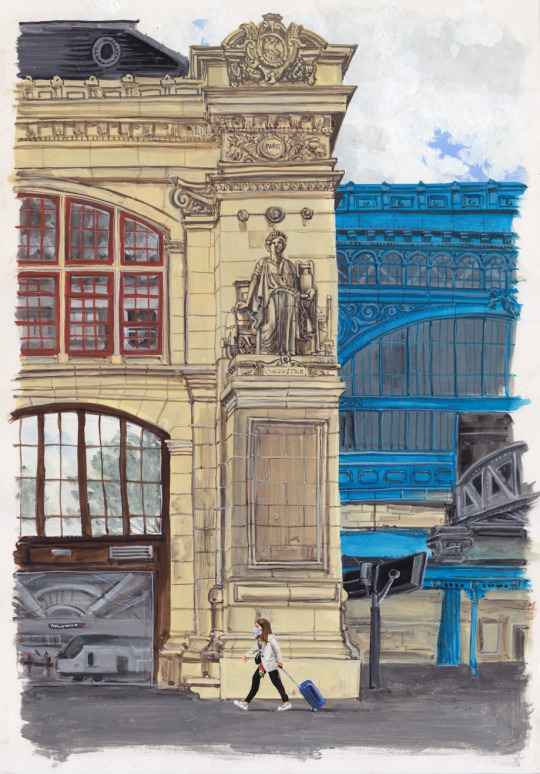
Cour du Départ, gare d’Austerlitz (Paris 13e) – gouache format A3, mai 2021.
VISIBLE dans l’exposition VILLE, MER, CAMPAGNE, jusqu’au 18 novembre, galerie Arts Factory, 27, rue de Charonne, 75011 Paris, tous les jours sauf le dimanche de 12h30 à 19h30.
#2021#cour du depart#gare d'austerlitz#gare#paris#13e#passante#masque#valise#sculpture#industrie#gouache#paysage#paysage gouache#paysage gouache a3#station metro#fer#sncf#station#marche
37 notes
·
View notes
Text
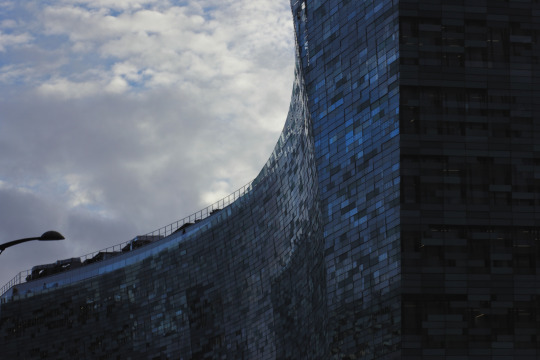
#original photographers#photography#photographers on tumblr#my art#paris#photooftheday#lensblr#paris city#city of paris#archi#architecture#architecture photography#architectural#modern architecture#gare d'austerlitz#paris france#parislife#glass tower
11 notes
·
View notes
Text

2024 Paris, gare d'Austerlitz
#2024#Paris#gare d'Austerlitz#ricohgrIIIx#photography#original photographers#streetphotography#color photography#pierre wayser
11 notes
·
View notes
Photo
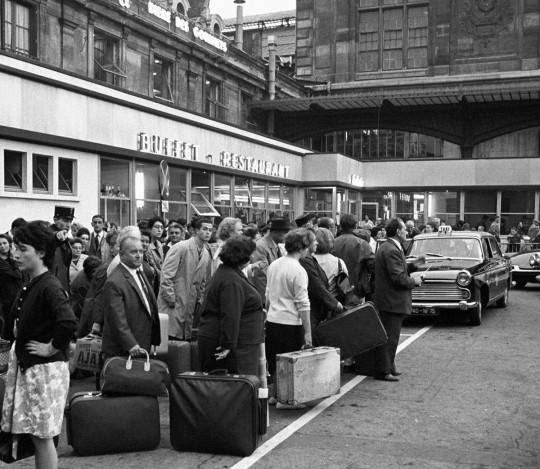
Paris Gare d'Austerlitz en 1963 - Photo Ina. - source John d'Orbigny Immobilier.
33 notes
·
View notes
Text

"A Voyage on the Diorient Express or The Princess Pocahontas" collection
Christian Dior Haute Couture Fall/Winter 1998 99
By John Galliano
#1990s fashion#paris#fashion gifs#john galliano#gifs#gif#1998#christian dior#manolo blahnik#stephen jones#haute couture#pocahontas#diorient express#fall winter#1999#gare d'austerlitz#anne boleyn
30 notes
·
View notes
Photo

Gare d'Austerlitz
Paris, France
Pascal Colin
#gare d'austerlitz#gare de paris-austerlitz#paris#île-de-france#13e#france#balayeurs#sweepers#pascal colin#photographe#photographie
14 notes
·
View notes
Text

4 notes
·
View notes
Text
VTC 91 | Chauffeur Privé Essonne
Vous souhaitez réserver un chauffeur privé à Paris ou en Ile-de-France ? Faites confiance à nos chauffeurs VTC et Taxis pour votre transport ou transfert sur le lieu que vous souhaitez.
VTC 91 | Chauffeur Privé Essonne
2 rue de l'épendoir, 91540 Ormoy
07 85 65 71 79
Ouvert 24h/24
#vtc#essonne#taxi#chauffeur#aéroport#shuttle#disneyland#garedelyon#gare d'austerlitz#garedunord#massy
1 note
·
View note
Text

#personal photos#personal#paris#master's degree#avril 2024#april 2024#april#spring in paris#cleaning day#keep fighting#la seine#trees#spring#quai de la gare#paris 13ème#quai d'austerlitz
5 notes
·
View notes
Text
Trains in Miraculous Ladybug - Bonus: The Bus
[Part 1: The Metro Train]
[Part 2: The Metro Station]
[Part 3: Startrain]
[Part 4: The Gare du Nord]
It’s been a while since I made these posts, but I figured I might as well update them, and talk about the remaining public transit vehicle in the show that hadn’t been mentioned yet: The bus, shown here almost in its natural habitat.

Just like most other vehicles, the show has just the one, which is always signed as line 33 to Gare d'Austerlitz. The line is strictly fictional, just like the Metro lines, to justify this bus appearing everywhere in the city.
So let's talk about the bus itself. In the show, it gets thrown around, used to escape Zombies, it loses its breaks at the start of Gladiator, it's an animal prison, it receives the least destructive cataclysm of all time (in Animan) and way more. While it has no logos, and a slightly distorted front end presumably to avoid copyright infringement (yes, vehicle design is covered by copyright), it is unmistakably an Agora by… well, that's difficult actually, because this bus type has a complicated history.


First picture by Vincent Babilotte, from Wikimedia Commons, CC-BY-SA; second by Eole99, from Wikimedia Commons, CC-BY-SA
The Renault Agora was introduced in 1996 as Renault's first fully low-floor bus. In 1999, Renault Véhicules Industriels (commercial vehicles) merged their bus business with Iveco, functionally the commercial vehicle division of Fiat if you squint a bit. The new joint venture was known as Irisbus, and from 2002, the Agora became known as Irisbus Agora. Their logo is actually a dolphin ouroboros if you look closely; I have no idea why.
At the same time Renault and Irisbus were also busy buying companies in eastern europe, and reused their names, which means the Agora was also sold under such famous names (famous among bus nerds anyway) as Karosa and Ikarus in Eastern Europe. Those seem to have been co-branding things, those buses still had either the Renault Rhombus or the Irisbus dolphin on the front, and then a Karosa or Ikarus logo somewhere on the side. Some buses were also sold as Škoda (the part that makes trains, not the part that makes cars). We'll get to those later. Finally, in some countries, it was sold under the incredibly vague name "Citybus".
For Paris, we'll only care about the Renault and Irisbus versions, though. These are functionally the same, they just differ in the logo on the front, which the Miraculous bus simply omits entirely. On the inside, the Irisbus version has newer Iveco engines instead of Renault ones to meet newer emission standards, but that's irrelevant from the outside.
The main feature to recognise this bus from a distance is actually in the rear.

In order to provide a flat floor from the front right to the last seating row, Renault has arranged the engine and related mechanical parts in a sort of backpack. An angled drive shaft drives the rear wheels, which are arranged as a portal axle (a design where there is a small gear set near each wheel so the axle in the middl can be higher or, in this case, lower than the wheel hubs). This design as such isn't unique to Renault; it is also found on some Scania OmniCity buses and several ones in the US, starting with the high-floor GMC Rapid Transit Series in the late 70s. What is unique about the Renault design is how it's packaged, with a gentle curve at the top.

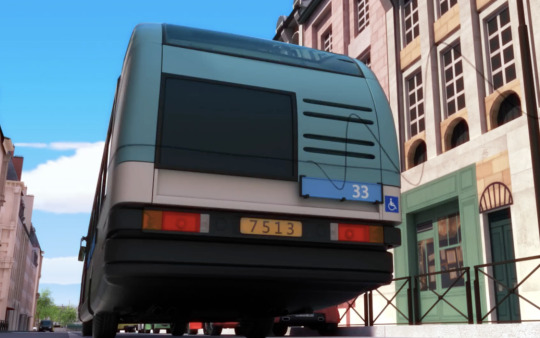
This design actually originated with the Renault R312, the Agora's predecessor, which was semi-high-floor (a single step to get into the bus), and continued to be used by the Agora's successor, the Irisbus Citelis, starting 2006. Here's the rear of one in Liège, Belgium:

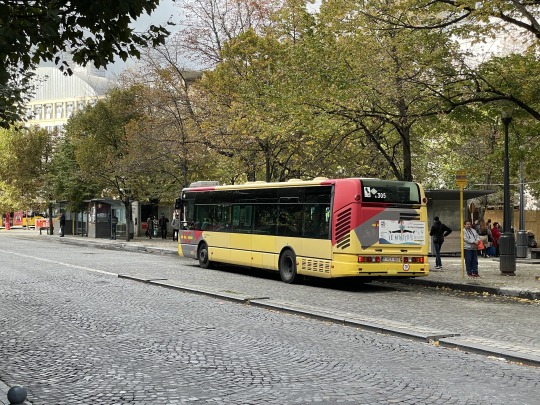
Pictures by me, do what you want with them
In real life, the curve is not quite as pronounced as it is in the show, and the show has given the bus's rear end a pronounced overbite. Again, I think that's due to copyright, but that's just a guess.
The buses also come with a variety of rear lights; the ones on these Belgian buses don't match any of the Agoras or Citelises I've seen in Paris. Either way, the same backpack, now with LED lights, is also used on the Citelis's successor, the Iveco Urbanway.
(Oh yes, in 2013, Iveco bought the remaining share of Irisbus and renamed the bus models to Iveco only, but it's still the same fundamental bus design somewhere in there. The rest of the commercial vehicle division of Renault was sold to Volvo around the time but keeps its name. Note, that's the Volvo that makes trucks, not the Volvo that builds cars, which is completely independent and owned by Geely. This confusing shit keeps happening and it keeps getting worse.)
For extra confusion, there's also a version of all three buses that doesn't have this backpack, and instead has the engine under a raised floor. I'm going to ignore this one here.
I really love all the little details they implemented on the bus, like the colored signs on the outside that show route information.
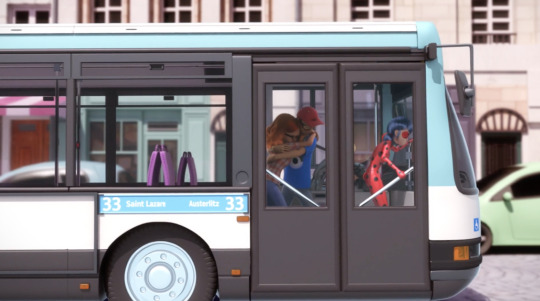
I have no idea why Paris uses these, the buses have digital displays as well, but I like them as a concept.
You can also see the frame for the advertising. In this case it's empty; in other episodes it has shown ads for Adrien, Le Perfume, or for the weather girl contest in Stormy Weather.
On the interior, I'll be honest with you, I'm not that knowledgeable about french buses.

I think the overall layout is correct, but I think the seat color is wrong. Buses and trams owned by Paris's transit operator RATP usually have green seats. Maybe that was another copyright issue? I know that sounds weird, but the transit operator of Berlin (BVG) was recently in a legal battle with the designer of their seat patterns over the question whether BVG could sell merchandise with that pattern. RATP does not have that problem because they sell barely any interesting merch, no matter how much I'd like to buy some.
Next: The dashboard.

We get actually fairly good looks at it in some episodes, in particular Animan, and it looks pretty good.

In partikular, it seems to be a fairly close match for the VDV-Standardfahrerarbeitsplatz, seen here in a Citelis.
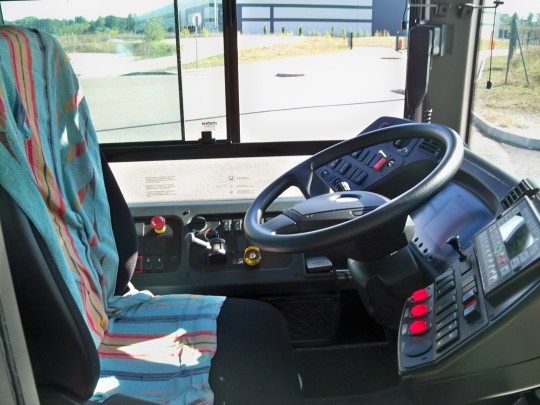
The buttons for the automatic transmissions are in different places here, but both versions seem to be available. Also note that this one has a display unit built in, but it seems that is also optional. The one in Miraculous Ladybug has a separate bus computer unit mounted next to the dashboard, which is a very common layout as well.
As the name implies, the VDV Standardfahrerarbeitsplatz is a german invention by an association of bus operators, who have standardised how a bus dashboard should look like. While bus manufacturers can offer their own, and some do, the standard design is usually also available. The advantage is that if you have buses from three different manufacturers, then you only need to train drivers once instead of separately for each bus. Since german companies build a lot of buses, their standards have become relevant in other countries as well; such as France. Paris has a lot of german-built buses these days as well.
I know the Agora didn't always use the VDV dashboard; you can find pictures of a weird angular Renault design. I don't know if they switched, or if the german standard design became available as an option, and I don't know which version RATP used. But it's certainly a type of real bus dashboard, and one that was used by the same company later on, so I think it's okay.
In some episodes, notably Glaciator 2 and Qilin, we also see the ticketing.

Marinette apparently has a Navigo pass, a contactless card that you touch to the validator in the bus. That seems perfectly accurate. In Qilin, she has forgotten that card, but luckily her mom has bought single-use tickets.

In Paris, you need to validate such pre-bought tickets first, which she does by touching them to the RFID validator.

That's really not how it works in real life. Instead there's a distinct validator for these bus tickets that stamps them, but this bus model doesn't have that. It's okay enough, I guess.
The main issue with the interior of the bus is something else: It has a step.

That's a bit of a problem. In real life, the Agora does not have a step, the entire floor is flat. That was its main advantage over the older Renault R312, which did have the step. I have no idea why the show chose to include a step in here. They're consistent about it as well; there's a step at the rear door, too.
(By the way, do not think about where the doors go when they're open. It's different every episode. They're supposed to swing inwards, but sometimes they swing out, or they just disappear.)
My final nitpick would probably be the underside.
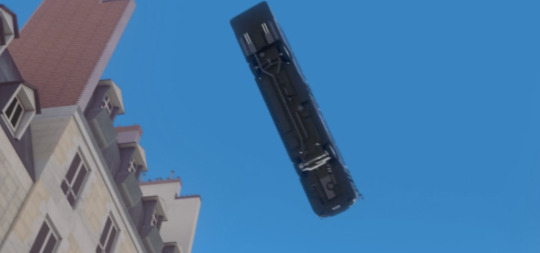
I have no idea what an Agora is supposed to look like from underneath. But given that the engine is in the back, it's probably not supposed to have exhaust lines running all the way under it. Yes, that's as minor a nitpick as they come, but I couldn't resist once I saw it.
Overall, though, it's a good bus, and very appropriate if you only have the money to model one. The Agora is definitely a staple of Parisian cityscapes, with more than 2500 delivered to RATP, almost a quarter of the entire production run.
If there's one issue with its inclusion in the show, it's the age. The last Agora was built in 2006, and most of them have long been retired. A number of them are already in RATP's vast historic collection, which is sadly not open to the public except on special occasions. I don't get why; there would definitely be interest, just look at the London transport museum. Paris's public transport is every bit as iconic as London's, but they don't market it as such, and they don't have the museums and merchandise to capitalise on it, and I think that's just sad. Please allow me to give you money, RATP!
Anyway, these days, no Agora can go into Paris anymore. Paris has established a low emission zone in 2017, and all Agoras are too old to be allowed in. There are some Agoras still running in the wider Paris region, but not the city centre proper (though that one still has some Citelises, and also some Heuliez versions, which is a whole other can of worms). If we assume that Miraculous Ladybug takes place in some sort of eternal 2014/2015, which is still the best guess for a timeline that I've seen, then the Agora still fits, but it would hardly be the only or most common bus anymore.
The age becomes an issue in one particular episode, in Bakerix, where Bakerix complains that the bus is electric, and that's not how it's supposed to be.
In real life, the Agora was never available as a battery electric bus. Paris is buying lots of battery electric buses these days, including ones that have some lineage to the Agora, but the original only ever had internal combustion engines…
…well, except for sometimes. There were also Trolleybus versions of the Agora. First, there is the Škoda 24Tr (normal version) or 25Tr (articulated version), which was confusingly built in two versions, one based on the Agora and one based on the Citelis. There is also an Irisbus Agora Trolleybus with electrical equipment by Škoda. Is that a different trolley bus based on the Agora built in cooperation between Škoda and Irisbus, or is it the same one, and they just sometimes branded it as a Škoda and sometimes as an Irisbus depending on local contracts? Your guess is as good as mine. Either way, though, those were only sold in Eastern Europe. Paris doesn't have any trolley bus wires, so there were no electric Agoras here, ever.
That aside, though, I think Miraculous Ladybug did overall really well on the bus, given the constraints they had to work with, and I'm looking forward to seeing it in plenty more episodes.
I think that's the end of this series, unless the show starts bringing the tram or the RER into it. I don't think they will, because I don't think they could tell any new stories that way, but I would greatly appreciate it. Anyway, thanks for reading!
[Part 1: The Metro Train]
[Part 2: The Metro Station]
[Part 3: Startrain]
[Part 4: The Gare du Nord]
#miraculous ladybug#renault agora#irisbus agora#agora#renault#irisbus#bus#public transit#train reviews#bus reviews
63 notes
·
View notes
Photo

Map of the Bièvre, a Parisian river which has its source in Guyancourt (Yvelines), and which after a 35 km journey, empties at the Gare d'Austerlitz. Since 1912, the Bièvre has been entirely covered in Paris.
by @LegendesCarto
66 notes
·
View notes
Text
Passer de tasser un mur en paille avec ses pieds le matin To marcher à gare d'austerlitz ça devrai pas être légal jai envie de chialer and die
5 notes
·
View notes
Text

"Le travail est à la vie ce que CNews est au cerveau..."
Métro Gare d'Austerlitz, Paris (XIIIe), 7 mars 2023
2 notes
·
View notes
Text

2023 Paris, gare d'Austerlitz
#2023#paris#gare d'Austerlitz#photography#original photographers#streetphotography#color photography#pierre wayser
8 notes
·
View notes
Photo

Gare d'Austerlitz. - source Automobiles Anciennes. Photos Et Cartes Postales D' époque.
32 notes
·
View notes
Text
Navigating Paris: A Guide to Train Station Transfers

Paris, the city of lights, romance, and art, is not only a cultural gem but also a bustling hub of transportation. With its extensive network of train stations connecting various parts of the city and beyond, navigating through Paris can sometimes be daunting, especially when it comes to transferring between stations. Whether you're a seasoned traveler or a first-time visitor, understanding the intricacies of train station transfers in Paris can greatly enhance your experience. Here's a comprehensive guide to help you navigate seamlessly through the Parisian train system.
Understanding Paris Train Stations:
Paris is served by several major train station transfer Paris, each catering to different regions and destinations. The primary stations include Gare du Nord, Gare de l'Est, Gare de Lyon, Gare Saint-Lazare, Gare Montparnasse, and Gare d'Austerlitz. These stations are not only crucial for domestic travel within France but also serve as gateways to international destinations such as London, Brussels, and beyond.
Planning Your Transfer:
Before embarking on your journey, it's essential to plan your transfer between train stations in advance. Start by identifying your arrival and departure stations, along with the mode of transport you intend to use. Paris offers various options for inter-station transfers, including metro, RER (Réseau Express Régional), buses, and taxis.
Metro and RER Connections:
The Paris metro and RER network provide convenient connections between different train stations. Gare du Nord, for instance, is well-connected to other major stations via metro lines 4 and 5, as well as the RER B line, which offers direct access to Gare de l'Est, Gare de Lyon, and Gare Montparnasse, among others. Similarly, Gare de Lyon is linked to Gare d'Austerlitz via metro line 14, facilitating easy transfers for travelers.
Bus Services:
In addition to the metro and RER, Paris boasts an extensive bus network that connects various parts of the city, including train stations. Bus routes such as 20, 65, and 91 offer convenient transfers between Gare Saint-Lazare, Gare de Lyon, and other stations, providing travelers with alternative transportation options.
Taxi and Ride-Hailing Services:
For those seeking a more direct and comfortable transfer experience, taxis and ride-hailing services are readily available in Paris. Taxis can be hailed directly from the street or booked in advance, while ride-hailing platforms like Uber and Lyft offer convenient options for travelers with smartphones.
Navigating Transfer Hubs:
Certain stations in Paris serve as major transfer hubs, facilitating smooth transitions between different modes of transport. Châtelet-Les Halles, for instance, is one such hub that connects multiple metro and RER lines, making it an ideal transfer point for travelers navigating between different train stations.
Tips for Seamless Transfers:
Familiarize yourself with the Parisian train network and station layouts before your journey.
Allow ample time for transfers, especially during peak hours or in case of unforeseen delays.
Purchase tickets or passes in advance to avoid last-minute hassles.
Stay informed about any service disruptions or schedule changes via official transport apps or websites.
When in doubt, don't hesitate to ask station staff or fellow travelers for assistance.
Conclusion:
Navigating train station transfers in Paris can be a breeze with proper planning and awareness of available transportation options. Whether you're transferring between Gare du Nord and Gare de l'Est or navigating from Gare de Lyon to Gare Montparnasse, understanding the intricacies of Parisian transport can enhance your overall travel experience. By following the tips outlined in this guide, you can navigate seamlessly through the city's bustling train network and focus on enjoying all that Paris has to offer.
1 note
·
View note